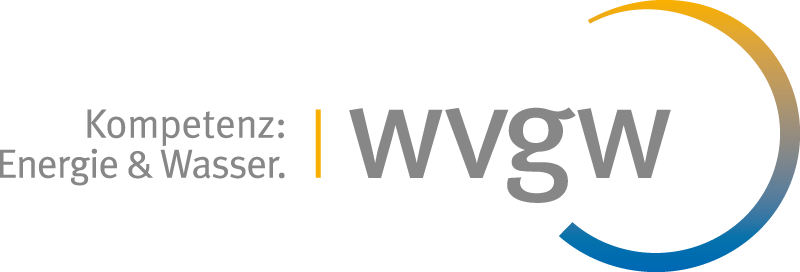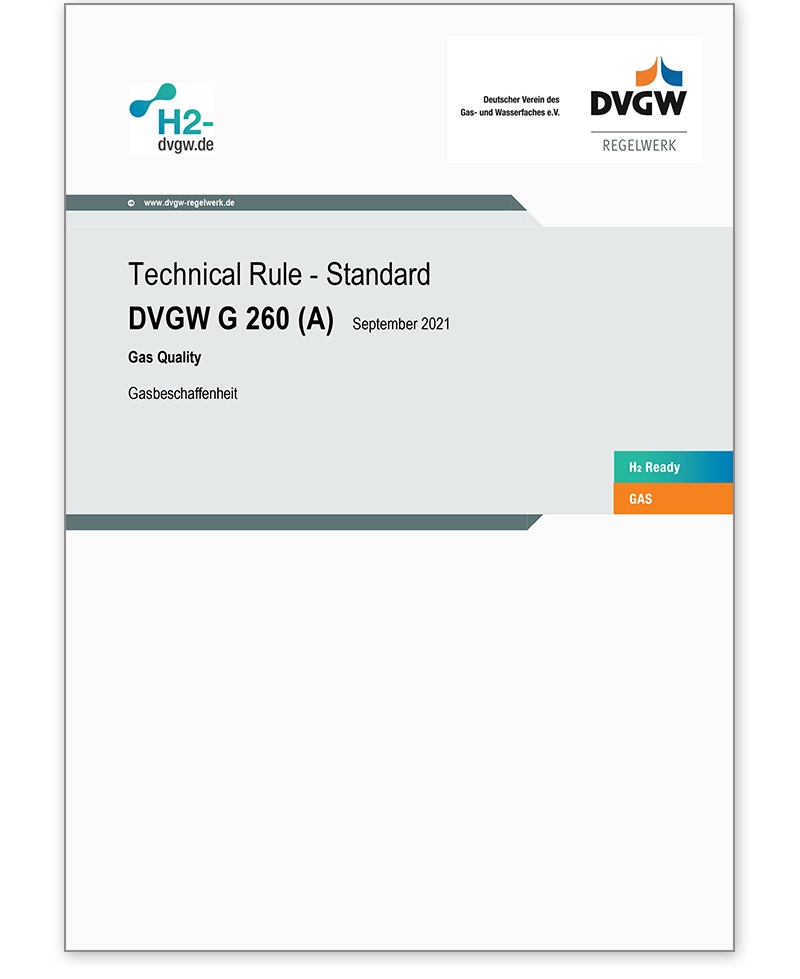G 260 Technical Rule 09/2021
Gas Quality ++ PDF file ++
- Herausgeber/Verlag: DVGW
- Format: 52 pages
- Material: available as PDF only
- Ausgabe: 2021
- Hinweis: German version G 260
- Verkaufseinheit: 1
- Mindestabnahme: 1
- Artikel-Nr.: 511831
110,68 €*
This Technical Rule G 260 specifies the
requirements for the quality of fuel gases used
in the supply of the general public with gas and
sets the parameters for gas delivery, gas
transportation, gas distribution, gas storage,
operation of gas plants/systems and gas
appliances for commercial and industrial gas
applications as well as for development,
standardization, and testing.
Gases transported in separate pipelines which are
not used in the supply of the general public, or
are used as energy carrier or resource, and/or
are used in special gas appliances are not
subject to the scope of this Technical Rule.
Preface
List of Symbols, Units, and Indices
1 Scope
2 Normative References
2.1 DVGW Sets of Rules
2.2 Standards
2.3 Other Technical Rules
2.4 Acts and Ordinances
2.5 Provisions Based on Regulations
3 Terms, Symbols, Units
3.1 Combustible Gases
3.1.1 Natural Gas
3.1.2 Renewable Gases
3.1.3 Other Combustible Gases
3.2 Reference Gases
3.3 Conditioning Gases
3.4 Test Gases
3.5 Substitute Gases
3.6 Supplemental Gases
3.7 Network Cell with Renewable Gas Injection
3.8 Gas Families, Groups
3.9 State, State Variables, Gas Law Deviation Factor, Compressibility Factor, Humidity
3.9.1 State
3.9.2 Reference Conditions
3.9.3 State Variables
3.9.4 Gas Deviation Factor, Compressibility Factor
3.9.5 Humidity
3.10 Gas Volume
3.11 Gas Constituents
3.12 Combustion Characteristics
3.12.1 Gross (Superior)and Net (Inferior) Calorific Values
3.12.2 Density
3.12.3 Relative Density
3.12.4 Wobbe Index
3.12.5 Gas Supply Pressure
3.13 Methane Number
3.14 Water Content
3.15 Water Dew Point
3.16 Hydrocarbon Dew Point
3.17 Pressure
3.18 Maximum Operating Pressure (MOP)
3.19 Gas Infrastructure
4 Requirements on Gas Quality
4.1 Limit Values for Combustion Characteristics, Gas Constituents, Gas Accompanying Substances
4.2 Additional Information on Combustion Characteristics
4.2.1 Wobbe Index, Superior Calorific Value
4.2.1.1 General
4.2.1.2 Nominal Value
4.2.1.3 Allowable Variation
4.2.1.4 Adjusting Gas Appliances
4.2.1.5 Adjustment Values
4.2.1.6 Regulations for Exceptions
4.2.2 Relative Density
4.2.3 Methane Number
4.3 Additional Information on Gas Constituents and Gas Accompanying Substances
4.3.1 General
4.3.2 Methane Content in Upgraded Biogas (Biomethane, SNG)
4.3.3 Higher Hydrocarbons
4.3.4 Water
4.3.5 Oxygen
4.3.6 Carbon Dioxide
4.3.7 Mist, Dust
4.3.8 Sulfur Compounds
4.3.9 Ammonia and Amines
4.3.10 Organosilicon Compounds
4.3.11 Hydrogen
4.3.11.1 Hydrogen as Supplemental Gas
4.3.11.2 Hydrogen as Reference gas
5 Supplemental Rules for Gases of the 2nd Gas Family
5.1 General Remarks
5.2 Gases for Conditioning
5.2.1 Air, Nitrogen
5.2.2 Natural Gases of Other Quality
5.2.3 Liquified Petroleum Gases
5.3 Supplemental Gases
5.3.1 Liquefied-Petroleum-Gas/Air-Mixtures
5.3.2 Reaction and ShutdownTimes
5.4 Substitute Gases
5.5 Network Cell with Injection of Renewable Gases
Annex A (informative) – Examples for the Composition of Some Gases of the 2nd Gas Family
Annex B (informative) – Classification of Gases According to Gross Calorific Value, Wobbe Index and Relative Density
Annex C (informative) – Water Dew Point in Relation to Gas Pressure
Annex D (informative) – Hydrogen
D.1 Limitation of Hydrogen Addition due to Combustion Characteristics of the Blended Gas
D.2 Limitation by Special Properties of Hydrogen and Interactions with Parts of the Gas Infrastructure and Gas Applications
D.3 Hydrogen Transportation Networks (5th Gas Family)
D.4 Development of and Outlook on Hydrogen Injection into Networks of the 2nd Gas Family
Annex E (informative) – Wobbe Index Variation and Fluctuation Range
E.1 Information Concerning the Wobbe Index Band
E.2 Developing a Wobbe Index Fluctuation Range
Annex F (normative) – Maximum Guidance Values for Gas Accompanying Substances (excerpt from annex A.5, taken from DVGW Code of Practice G 260, Version of May 2008)
Annex G (informative) – Removal of Siloxanes
Further Reading
List of Symbols, Units, and Indices
1 Scope
2 Normative References
2.1 DVGW Sets of Rules
2.2 Standards
2.3 Other Technical Rules
2.4 Acts and Ordinances
2.5 Provisions Based on Regulations
3 Terms, Symbols, Units
3.1 Combustible Gases
3.1.1 Natural Gas
3.1.2 Renewable Gases
3.1.3 Other Combustible Gases
3.2 Reference Gases
3.3 Conditioning Gases
3.4 Test Gases
3.5 Substitute Gases
3.6 Supplemental Gases
3.7 Network Cell with Renewable Gas Injection
3.8 Gas Families, Groups
3.9 State, State Variables, Gas Law Deviation Factor, Compressibility Factor, Humidity
3.9.1 State
3.9.2 Reference Conditions
3.9.3 State Variables
3.9.4 Gas Deviation Factor, Compressibility Factor
3.9.5 Humidity
3.10 Gas Volume
3.11 Gas Constituents
3.12 Combustion Characteristics
3.12.1 Gross (Superior)and Net (Inferior) Calorific Values
3.12.2 Density
3.12.3 Relative Density
3.12.4 Wobbe Index
3.12.5 Gas Supply Pressure
3.13 Methane Number
3.14 Water Content
3.15 Water Dew Point
3.16 Hydrocarbon Dew Point
3.17 Pressure
3.18 Maximum Operating Pressure (MOP)
3.19 Gas Infrastructure
4 Requirements on Gas Quality
4.1 Limit Values for Combustion Characteristics, Gas Constituents, Gas Accompanying Substances
4.2 Additional Information on Combustion Characteristics
4.2.1 Wobbe Index, Superior Calorific Value
4.2.1.1 General
4.2.1.2 Nominal Value
4.2.1.3 Allowable Variation
4.2.1.4 Adjusting Gas Appliances
4.2.1.5 Adjustment Values
4.2.1.6 Regulations for Exceptions
4.2.2 Relative Density
4.2.3 Methane Number
4.3 Additional Information on Gas Constituents and Gas Accompanying Substances
4.3.1 General
4.3.2 Methane Content in Upgraded Biogas (Biomethane, SNG)
4.3.3 Higher Hydrocarbons
4.3.4 Water
4.3.5 Oxygen
4.3.6 Carbon Dioxide
4.3.7 Mist, Dust
4.3.8 Sulfur Compounds
4.3.9 Ammonia and Amines
4.3.10 Organosilicon Compounds
4.3.11 Hydrogen
4.3.11.1 Hydrogen as Supplemental Gas
4.3.11.2 Hydrogen as Reference gas
5 Supplemental Rules for Gases of the 2nd Gas Family
5.1 General Remarks
5.2 Gases for Conditioning
5.2.1 Air, Nitrogen
5.2.2 Natural Gases of Other Quality
5.2.3 Liquified Petroleum Gases
5.3 Supplemental Gases
5.3.1 Liquefied-Petroleum-Gas/Air-Mixtures
5.3.2 Reaction and ShutdownTimes
5.4 Substitute Gases
5.5 Network Cell with Injection of Renewable Gases
Annex A (informative) – Examples for the Composition of Some Gases of the 2nd Gas Family
Annex B (informative) – Classification of Gases According to Gross Calorific Value, Wobbe Index and Relative Density
Annex C (informative) – Water Dew Point in Relation to Gas Pressure
Annex D (informative) – Hydrogen
D.1 Limitation of Hydrogen Addition due to Combustion Characteristics of the Blended Gas
D.2 Limitation by Special Properties of Hydrogen and Interactions with Parts of the Gas Infrastructure and Gas Applications
D.3 Hydrogen Transportation Networks (5th Gas Family)
D.4 Development of and Outlook on Hydrogen Injection into Networks of the 2nd Gas Family
Annex E (informative) – Wobbe Index Variation and Fluctuation Range
E.1 Information Concerning the Wobbe Index Band
E.2 Developing a Wobbe Index Fluctuation Range
Annex F (normative) – Maximum Guidance Values for Gas Accompanying Substances (excerpt from annex A.5, taken from DVGW Code of Practice G 260, Version of May 2008)
Annex G (informative) – Removal of Siloxanes
Further Reading

